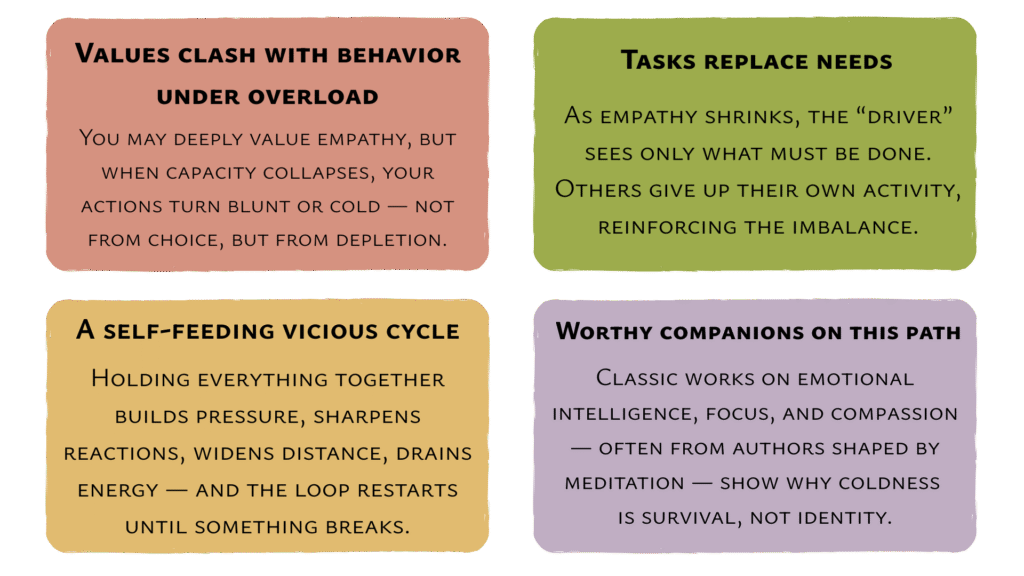Facts
- Capacity vs. character: Chronic stress reduces activity in the brain’s prefrontal cortex — the part responsible for emotional regulation. Reactions become sharper not because values change, but because capacity is depleted.
- Empathy requires energy: When caregivers are overloaded, their measured empathy levels drop, even though their values remain pro-social.
- Misinterpretation risk: In families, partners and children often confuse signals of overload (distance, coldness) with identity. This deepens isolation.
- Cultural bias: In high-performance environments, bluntness is sometimes rewarded. But at home, the same bluntness is seen as rejection.
—
Unseen angles
- When an overloaded person “carries everything” and holds the system together, power and responsibility concentrate on their side—often unintentionally.
- As empathy shrinks, the driver sees tasks instead of needs.
- Others gradually give up their own activity and learn to rely on the “driver,” which reinforces the imbalance.
- This asymmetry deepens the cycle: the more one carries, the less space remains for others to act. ⠀
—
Extensions
Schema explanation:
| Observable state / behavior | Invisible dynamic leading forward |
|---|---|
| Holding everything together – managing tasks, family, projects, responsibilities | Pressure builds – no pause or real relief |
| Sharp reactions – outbursts, blunt comments, colder tone | Only harshness seen – others do not see the effort behind it, but notice just the edge |
| Perceived as hard / unsupportive – seen as distant, strict, controlling | Distance grows – feedback turns negative |
| Lonely and misunderstood – feeling isolated even among close ones | Energy drains – connection erodes |
| Carrying the load feels unbearable – exhaustion shows in body and mood | Cycle restarts – no release, so the loop begins again |
—
Links
Daniel Goleman – Emotional Intelligence
- Relevance to overload: Shows how chronic stress undermines the brain’s capacity for emotional regulation, making reactions sharper and less empathetic. What may look like coldness is often just the amygdala overriding the prefrontal cortex.
- Wider content: Introduces the framework of emotional intelligence — self-awareness, self-regulation, empathy, motivation, and social skills. Goleman explains how these abilities predict success in leadership and relationships more than IQ. He covers neuroscience, workplace case studies, and practical strategies for building emotional competence.
⠀Daniel Goleman – Focus: The Hidden Driver of Excellence
- Relevance to overload: Explains how attention becomes hijacked under pressure, narrowing awareness and leaving little bandwidth for empathy or warmth. When focus collapses into tunnel vision, relationships suffer.
- Wider content: The book explores three levels of attention: inner focus (self-awareness), other focus (empathy), and outer focus (systems and strategy). Goleman argues that true excellence requires balancing these. He uses examples from sports, business, and education to show how sustained focus leads to resilience, better decision-making, and long-term performance.
⠀Paul Gilbert – The Compassionate Mind
- Relevance to overload: Describes how stress, shame, or exhaustion switch off the “compassion system.” Cold or blunt behavior is framed as a survival strategy, not a permanent trait. Empathy and warmth require safety and energy.
- Wider content: Gilbert introduces Compassion Focused Therapy (CFT), a model integrating evolutionary psychology, neuroscience, and mindfulness. He explains the three emotional regulation systems — threat, drive, and soothing — and how imbalance leads to anxiety, perfectionism, or harsh self-criticism. The book provides practical exercises to build compassion for oneself and others, offering tools to counteract shame and chronic stress.
⠀
